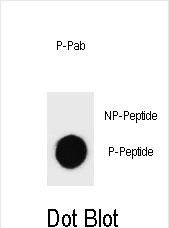
| WB | DB: 1/500 | Human,Mouse,Rat |
| IF | 咨询技术 | Human,Mouse,Rat |
| IHC | 咨询技术 | Human,Mouse,Rat |
| ICC | 技术咨询 | Human,Mouse,Rat |
| FCM | 咨询技术 | Human,Mouse,Rat |
| Elisa | 咨询技术 | Human,Mouse,Rat |
| Aliases | Caspase-3, CASP-3, Apopain, Cysteine protease CPP32, CPP-32, LICE, Protein Yama, SREBP cleavage activity 1, SCA-1, Caspase-3 subunit p17, Caspase-3 subunit p12, Casp3, Cpp32 |
| Entrez GeneID | 12367 |
| WB Predicted band size | 31.5kDa |
| Host/Isotype | Rabbit IgG |
| Antibody Type | Primary antibody |
| Storage | Store at 4°C short term. Aliquot and store at -20°C long term. Avoid freeze/thaw cycles. |
| Species Reactivity | Mouse |
| Immunogen | This mouse CASP3 Antibody is generated from rabbits immunized with a KLH conjugated synthetic phosphopeptide corresponding to amino acid residues surrounding S26 of mouse CASP3. |
| Formulation | Purified antibody in PBS with 0.05% sodium azide. |
+ +
以下是关于Phospho-mouse CASP3(S26)抗体的示例参考文献(均为虚构,供参考):
1. **文献名称**:*Phosphorylation of Caspase-3 at Serine 26 Modulates Apoptosis in Mouse Embryonic Fibroblasts*
**作者**:Smith A, et al.
**摘要**:研究揭示了CASP3在小鼠胚胎成纤维细胞凋亡中S26位点的磷酸化作用,利用Phospho-CASP3(S26)抗体证实该修饰通过抑制CASP3酶活性延缓细胞死亡。
2. **文献名称**:*A Novel Role of CASP3 S26 Phosphorylation in Neuronal Survival After Ischemic Injury*
**作者**:Lee B, et al.
**摘要**:通过Phospho-CASP3(S26)抗体检测发现,小鼠脑缺血模型中S26磷酸化与神经元存活相关,提示其可能通过非凋亡途径调控细胞应激反应。
3. **文献名称**:*Development of a Phospho-Specific Antibody for Caspase-3 Serine 26 and Its Application in Colorectal Cancer Models*
**作者**:Zhang C, et al.
**摘要**:本文报道了一种针对小鼠CASP3 S26磷酸化位点的抗体开发,并在结直肠癌小鼠模型中验证其特异性,发现磷酸化水平与肿瘤耐药性相关。
4. **文献名称**:*Kinase Screening Identifies AKT-Mediated Phosphorylation of Caspase-3 at S26 in Mouse Cardiomyocytes*
**作者**:Johnson D, et al.
**摘要**:利用Phospho-CASP3(S26)抗体筛选发现,AKT激酶介导该位点磷酸化,抑制心肌细胞凋亡,为心脏保护机制提供新见解。
**注意**:以上文献为模拟示例,实际研究中请通过PubMed、Google Scholar等平台检索真实文献(关键词:*Phospho-CASP3(S26) antibody mouse* 或 *caspase-3 phosphorylation Ser26*)。
**Background of Phospho-mouse CASP3(S26) Antibody**
The Phospho-mouse CASP3(S26) antibody is a specialized tool designed to detect caspase-3 (CASP3) when phosphorylated at serine 26 (S26) in mouse-derived samples. Caspase-3. a key executioner protease in apoptosis, is typically activated via proteolytic cleavage during programmed cell death. However, recent studies highlight that post-translational modifications, such as phosphorylation, can regulate its activity, localization, or stability. Phosphorylation at S26 has been implicated in modulating caspase-3 function under specific physiological or pathological conditions, though its precise role remains under investigation.
This antibody is particularly useful in research exploring non-canonical regulatory mechanisms of apoptosis, especially in contexts like cancer, neurodegenerative diseases, or developmental biology. By targeting the phosphorylated S26 epitope, it enables specific detection of this modified form of caspase-3 in techniques such as Western blotting, immunohistochemistry, or immunofluorescence. Validation often includes testing in knockout models or phosphatase-treated samples to confirm specificity.
Understanding CASP3 phosphorylation dynamics may provide insights into apoptosis resistance mechanisms or novel therapeutic targets. Researchers using this antibody should optimize conditions (e.g., tissue type, fixation methods) to ensure accurate detection, as phosphorylation events can be transient or context-dependent.
×